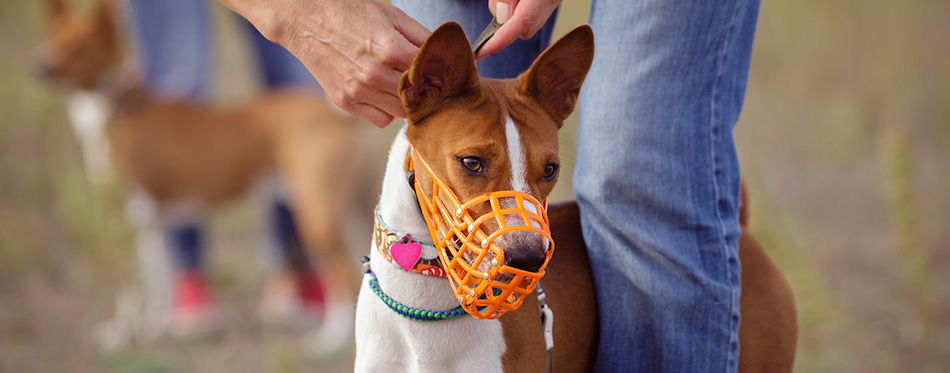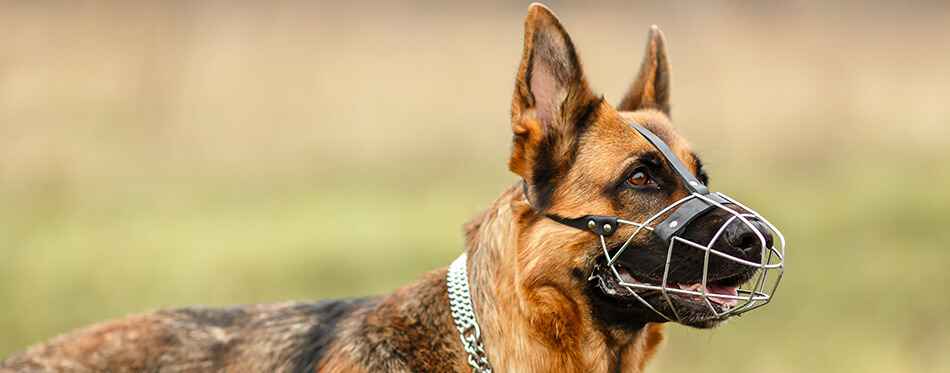A dog may need to wear a muzzle for many reasons and their responsible use can make them helpful in the day-to-day management, comfort and safety of your pet. But when it comes to something new, your dog will need time and plenty of reassurance so they can get used to wearing their muzzle.
Training your pet to accept their muzzle is an important first step. We take a look at why and when you may need to use a muzzle and how to positively train your pet to wear it.
What is a Dog Muzzle?
Simply put, a dog muzzle is a cover that’s placed over a dog’s snout to keep it from biting, chewing or excessively opening their mouth. Some muzzles are solid, with air holes so the dog can breathe, while others are made from straps which also allows them to comfortably pant, drink and even eat.

The Benefits of Using a Muzzle
There are some negative connotations associated with a muzzle, with the assumption that a dog wearing one is aggressive or even dangerous. While muzzles are used to prevent a dog from biting, their use is much more beneficial that that.
You may find you need to muzzle your dog to keep him and others safe from injury in the following scenarios:
They are reactive: Some dogs just don’t like other dogs, or they may have a strong prey drive or react if scared, meaning you could have a biting dog on your hands. If you know your dog and believe them to be aggressive, have a bite history or can potentially bite, then using a muzzle in public situations or near other dogs is the responsible thing to do, along with behavior training to get to the root of their aggression problem.
A new situation: A new or stressful situation that could be perceived by your dog as threatening can raise the risk of them biting, even if they’re not known to have aggressive behavior. Visits to the veterinarian for an examination is one example. A muzzle can be a temporary solution to ensure your pet gets the treatment or attention they need, especially if they are in pain or fear, while keeping other dogs and people safe.
There’s an emergency: An injured or scared dog is more likely to bite, so if you need to contain and move a dog in an emergency situation, using a muzzle as a piece of essential safety equipment will keep you and others safe and the frightened animal under control.
They don’t like to be groomed: Not all dogs like to be touched when it comes to grooming or getting their nails trimmed so you may need to use a muzzle to get your pooch washed and cleaned. Many dog groomers, especially if they are unfamiliar with a dog, will also ask for them to be muzzled.
They are required by law: Some states have Breed Specific Legislation which requires dogs from designated ‘dangerous breeds’ to wear a muzzle when not on the owner’s private property.
Types of Muzzles you Can Buy
The best dog muzzles are going to make training your pet to get used to wearing a muzzle much easier and there are two main types to choose from – the basket muzzle and the nylon. Basket muzzles look like the name suggests, and are made from straps, which allows your dog the freedom to also pant and drink when wearing one. A nylon muzzle actually prevents a dog from opening its mouth and should only be used for very short periods of time, such as a visit to the vet as they can lead to overheating if left on for too long.
Whichever type of muzzle you choose, it’s important to make sure it fits well and is comfortable for your pet to wear.
Muzzle Training: How It Can Benefit Your Pet
Using a positive reinforcement training plan so your pet gets used to wearing a muzzle is important as not all dogs love wearing a muzzle, and many can be resistant to the idea. Here’s how to teach your dog to be comfortable wearing their muzzle, step by step:
Step 1 – Take your time
Not every dog enjoys wearing a muzzle, especially for the first few times, so you need to make your training plan is positive and stress-free. Any negative association can make your pet more resistant so take your time and use treats as your reward-based training tool. Depending on your dog, you should allow several days to get your pooch to the point where they can wear their muzzle for a period of time, without fighting against it or getting stressed. And going at your dog’s pace during your muzzle training plan will reap long-term results.
You May Also Like: Dog Treats and Vegan Dog Treats
Step 2 – Introduce the muzzle
Never try to force a muzzle onto your dog’s head right away but start by letting your pooch explore it and have a good sniff. Reward them for their interest with treats and lots of praise. Repeat as many times as you need to get your pup comfortable being near it before you take the muzzle away.
Step 3 – Start with their nose in the muzzle
Once your dog is comfortable around the muzzle, place a treat or a smear of peanut butter just on the inside of the muzzle, so they need to put their snout in to get their prize. Gradually add the treats further inside the muzzle so eventually your pet has to put their whole snout willingly inside to get their reward. Make sure you never push the muzzle onto their face, let them go at their own pace and say out loud, ‘muzzle on’, every time they reach their reward.
Step 4 – Move to the straps
Once your dog is happy to put their nose inside the muzzle, move onto the straps, but don’t start by fastening them straight away but hold the strap ends at the back of their head. Reward with praise then remove the muzzle, leave it a while and repeat until they get used to the sensation of the straps too. You can also progress to just fastening the strap clip around their neck, without their nose in the muzzle, so they get used to the feel and sound.
Step 5 – Fasten the muzzle
Now their behavior is calm and happy, you can start putting the muzzle on to your dog’s nose and gently fasten the straps, praising and reassuring all the time they are wearing the muzzle. Unfasten the clips, let your dog remove their nose and reward with a treat then repeat until you are happy with your dog’s progress.
Step 6 – Increase their time in the muzzle
You are now onto the final stage of the muzzle training, and that’s to build up the time your dog is happy to wear a fastened muzzle. Start gradually, and slowly increase the time you leave the fastened muzzle in place, rewarding and praising your dog for their behavior. And once you have your dog wearing a muzzle for short periods around the house and yard, you are ready to start using it as necessary when out of the house or on their daily walks, which also creates fun associations with wearing it.

Using a Dog Muzzle – What Not to Do
Muzzles are not cruel if used appropriately and for the right reasons, so choosing the best muzzle, never forcing your dog to wear one and following our training guide will get your pet comfortably wearing one when needed.
But always be aware of how you use the muzzle with your pet and use it for enjoyable things (such as walks) as well as a vet visit for his jabs, so he doesn’t just associate it with fear. And he should always be able to breathe easily while wearing a muzzle, so be mindful of warmer weather conditions and not letting your pet wear it for too long. And finally, only use a muzzle on your dog when he is under your supervision.

